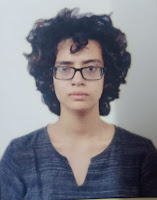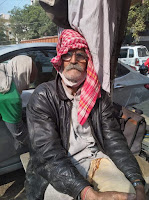A young boy relocating from bustling Karol Bagh to isolated CR Park in the 70s finds lifelong friendship through a club that started rather informally through a shared love for sports and culture. A freedom fighter teaching young boys the art of ‘lathi khela’ gets attracted to peals of laughter coming from a group of senior citizens sharing some sweets on some rocks beside a temple.
“What is it that fosters this vibrant club
culture in Bengali neighborhoods?” Asks Shomik, founding member of Shapno Ekhon
“These clubs are a product of the social
life and adda culture of Bengalis. The public-ness of everyday life provided an
inclusive and egalitarian space which fostered these clubs through shared
lives.” Responds Mritunjay Chatterjee.
The 12th session of the Adda series
organized by Shapno Ekhon held a discussion on the History of clubs in CR Park
on 4th June 2022. The panelists included eminent personalities including Mr
Partha Mitra- Photographer/filmmaker and an active member of South Delhi Youth
Center(SDYC); Mr Sujit Choudhary- AN engineer by profession, social organizer,
sports enthusiast, a well-known face in CR Park and another active member of
SDYC; NN Sarkar- - A freedom fighter who later became a squadron leader in the
Indian air-force and a member of the Morning Club; Mritunjay Chatterjee- an
artist practicing socially engaged art who has worked extensively on oral
history especially with women from Afghanistan and Somalia and member of Hoi
Hoi Sangha. The discussion was facilitated by Shahana and Shomik of
Neighborhood Diaries.
In today’s structured and fast paced world
where informal gatherings and activities just for the fun of it are
increasingly being seen as a ‘waste of time’, the discussions gave us a glimpse
of the past that is worth recreating. It took us back to a CR park that was
largely a barren terrain in the Aravalis, where having a playground meant
having to first clear out an empty rocky tract. A history so rich that even
those who were part of it are still discovering fascinating tidbits about it.
Eg. Bangia Samaj started in the house of Biplab and partha da’s parents’ homes
in 1973 and yet instead of joining this club they decided to form one on their
own which would later be known as SDYC
The SDYC club – Through the experiences
of Mr Sujit and Mr Partha
Mr Sujit’s introduction to the club life
happened in 1968 when he was a 3rd
grader taken under the wings of seniors at a club called Sabuj Sangha in
RK Puram. In the afternoons, alerted by the sound of a friend dribbling a
football outside his front porch, he would escape from the watchful supervision
of his grandmother. The playground near his home became an escape from
homework, it’s here where under the mentorship of seniors he learnt the art of
organizing Durga pujas with a mere budget of 4.5k (from putting up tents to
putting primer on the idols he took part in the entirety of the Puja process
with enthusiasm that can only be found in an energetic child entering
adolescence). Moving to CR park in 1973
he would wander about in his neighborhood on his cycle driven by a desire to
find a similar sense of community. By 1976 he was joined by Mr Partha as well
(who had moved from Karol Bagh and had been drawn into a group of older boys
who were particularly attracted to the football that he possessed). BY then
Durga Puja which was the glue of the probashi Bengali community in Delhi had
first split into two grounds- one in Mela grounds and the other in SDYC grounds
in j block and then into four- Mela ground, shiv mandir, K block and J block.
Shishir Chaterjee one of the founding members of SDYC also happened to be a
member of the youth congress and yet the culture of the club was so rooted in
the neighborhood’s shared life that at no point did it become a tool in the
hands of any political parties.
The club that began informally through the
shared love and appreciation for football, cultural experiences like Jatra,
organizing Durga Puja and Saraswati Puja has been witness to many historic
happenings culminating in the Asian games of 1982. As with football everywhere
passions often ran high and sometimes police had to be called in from Kalkaji
to settle the scuffles that would break out among the participating teams and
their supporters (including one involving the Afgani football team). From
playing carom in the garage of India’s first female commercial pilot Ms Durba
Banerjee to scoring goals against the professional Delhi football team; the
club has contributed to not just memories of their members but also in shaping
personalities and creating social cohesion in the community.
The morning Club- Through the
experiences of Mr NN Sarkar
A couple of retirees with hot tea in flask
spread out across a bunch of newspapers laid down on rocks outside the Shiv
Mandir. This seems like a sight one would be familiar with in the ‘rocker adda’
culture of Northern Calcutta; yet its ubiquitous whenever a group of Bengalis
have a chance meeting. Coming to the mandir to offer morning prayers led a
couple of older men to find health, happiness and company. This would
eventually evolve into the Morning club of CR Park. NN Sarkar in the early 80s
was then a middle aged man who had participated in the freedom movement through
his association with the Bengal Volunteers. Old habits die hard so rather than
letting his lathi khela skills go to waste, Mr Sarkar would spend his morning
hours passing on his skills to the youth of the area. It is then that his paths
crossed with the morning club members. In 1982 another freedom fighter, a
fellow comrade of Master da, Mr Das too found himself amidst the club. He was
in fact responsible for starting the tradition of starting off the day with
Vande mataram sung with passion and fervor. The regulars of the club over time
established their own rituals which included the establishment of a canteen
that served piping hot luchu-aloo, cultural programs on Sundays and
reading/discussion sessions on a regular basis. On rainy days a basement room
under the Kali mandir would be made available to the club members to carry on
with their discussions and festivities. As the word spread more people were
attracted to this spot amongst the noteworthy was Mr Ranadhir Sarma Sarkar who
had served as the law secretary under Nehru and would go onto becoming the
chairperson of UPSC. From religious texts, to discussions on poetry and
culture, to regular classes on diverse topics be it science or social science.
A vibrant and intellectually rich environment was created that kept both the
body and souls healthy and also created a culture of mutual care and concern
Hoi Hoi Sangha- Through the experience
of Mr Mritunjay Chatterjee
Mr Chatterjee came to CR Park in 1977. Back
then there were only two lanes of houses in the block where he resided. The
sparse population however didn’t deter a group of about 15 young boys to
collectivize around football and organizing Saraswati puja. The time he spent
in CR park would often remind him of his childhood in Sarojini nagar where he
would spend hours observing the likes of Tom Roy honing their skills on the
field. The crowd of younglings was so boisterous that the name of the club was
derived to match their energy level. The enthusiasm didn’t stop at just sports
but extended to plays as well that were often written and directed by the
mothers and aunts of the lot. Later Mr Krishnendu Chakrabarty would take on the
role of director. Be it running around with torches during load shedding or
putting up plays on the rooftops, just the fun of doing activities is what
motivated them to try their hands at anything and everything including the
indomitable art of Jatra. The dedication to fulfilling a task for the sole
purpose of deriving pleasure out of a collective task was so great that even a
bomb scare in the 1980s didn’t stop the group from putting up a great play for
the community (even though the venue had to be shifted from the mela grounds to
the rooftops of homes.
Screening of films through hired
projectors, occasional picnics, enthusiastic participation in football matches
that gathered a fan following among local fruit sellers and taxi drivers were
some of the common threads of experiences that united these clubs in Cr Park.
The streets of CR park have seen footballers like Bidesh Bose gulp down 7-8
pieces of fish after a tournament, diplomats, bureaucrats, freedom fighters
alike spend hours on debates and discussions, plays put up by famous
playwrights like Utpal Dutt. Under the watchful eyes of seniors, the junior
members would learn life lessons. The egalitarian nature of the clubs, space
for having heated discussions ranging across different shades of opinions,
hosting political plays without politicizing/polarizing everyday lives etc are
both products of a very public life of Bengalis as well as a contributing
factor in holding the same community together. Threads of relationships beyond
kinship ties were fostered through the ‘elomelo’ process of gradual club
formations. While some parts of this publicness we still hold on to while
organizing Durga pujas, there is much to this process that we need to treasure
and bring back in our neighborhoods today.










































